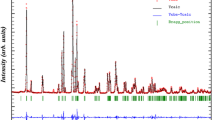Abstract
The lithium dihydrogen phosphate LiH2PO4 has been investigated by X-ray powder diffraction, scanning electron microscopy (SEM), and electrical impedance spectroscopy. The Rietveld refinements based on the XRD patterns show that the compound is crystallized in the orthorhombic system with Pna21 space group, and the refined unit cell parameters are a = 6.2428 Å, b = 7.6445 Å, and c = 6.873 Å. The electrical properties were studied using complex impedance spectroscopy as a function of frequency (104–107 Hz) at various temperatures (300–400 K). The Nyquist plots are well fitted to an equivalent circuit consisting of a series of combination of grains and inhomogeneous electrode surface effect. The frequency dependence of the conductivity is interpreted in terms of Jonscher’s law. Moreover, the near value of the activation energies obtained from the equivalent circuit and analysis of M″ confirms that the transport is through ion hopping mechanism dominated by the motion of the proton in the structure of the investigated material.













Similar content being viewed by others
References
Kumaresan P, Moorthy Babu S, Anbarasan PM (2008) Effect of irradiation of swift heavy ions on dyes-doped KDP crystals for laser applications. J Cryst Growth 310:1999–2004
Havlin S (1987) Longitudinal and transverse dielectric constants of KDP-type ferro- and antiferroelectrics. Ferroelectrics 71–72:183–223
Haile SH, Boysen DA, Chisholm CRI, Merle RB (2001) Solid acids as fuel cell electrolytes. Nature 410:910
Uda T, Boysen DA, Haile SM (2005) Thermodynamic, thermomechanical, and electrochemical evaluation of CsHSO4. Solid State Ionics 176:127
Lee H-S (1996) Hidden nature of the high-temperature phase transitions in crystals of KH2PO4-TYPE : Is it a physical change? J Phys Chem Solids 57:333
Castillo J, Materon EM, Castillo R, Vargas RA, Bueno PR, Varela JA (2009) Electrical relaxation in proton conductor composites based on (NH4)H2PO4/TiO2. Ionics 15:329
Cotton FA, Frenz BA, Hunter DL (1975) The structure of potassium hydrogen sulfate. Acta Crystallogr B 31:302
Pepinsky R, Vedam K, Okaya Y, Hoshino S (1958) Ammonium Hydrogen Sulfate: A New Ferroelectric with Low Coercive Field. Phys Rev 111:1508
Pepinsky R, Vedam K (1960) Ferroelectric Transition in Rubidium Bisulfate. Phys Rev 117:1502
Boysen DA, Uda T, Chisholm CRI, Haile SM (2004) High-Performance Solid Acid Fuel Cells Through Humidity Stabilization. Science 303:68–70
Uda T, Haile SM (2005) High-Performance Solid Acid Fuel Cells Through Humidity Stabilization. Electrochem Solid State Lett 8:A245–A246
Rietveld HM (1969) A profile refinement method for nuclear and magnetic structures. J Appl Crystallogr 2:65–71
Rodriguez-Carvajal J (1993) Recent advances in magnetic structure determination by neutron powder diffraction. Physica B 192:55–69. For more details on the FULLPROF Suite of programs consult the site: https://www.ill.eu/sites/fullprof/. Available online 30 July 2002
Abramoff MD, Magelhaes PJ, Ram SJ (2004) Image processing with ImageJ. Biophoton Int 11:36–42
Catti M, Ivaldi G (1977) Crystal structure of LiH2PO4 structural topology and hydrogen bonding in the alkaline dihydrogen orthophosphates. Z Kristallogr 146:215
Collins T (2011) Optical and Digital Image Processing. 859–877. For more details on the image J suite of programs consult the site: https://imagej.nih.gov/ij/download.html. Available online: 29 Apr 2011
Hodge IM, Ingram MD, West AR (1976) Impedance and modulus spectroscopy of polycrystalline solid electrolytes. J Electroanal Chem 74:125
Jonscher AK (1975) The Interpretation of Non-Ideal Dielectric Admittance and Impedance Diagrams. Phys State Sol (A) 32:665–667
Selvasekarapandian S, Vijaykumar M (2003) The ac impedance spectroscopy studies on LiDyO2. Mater Chem Phys 80:29–33
Plocharski J (1988) PEO based composite solid electrolyte containing nasicon. Solid State Ionics 28:979–982
Ram M (2010) Synthesis and electrical properties of (LiCo3/5Fe1/5Mn1/5)VO4 ceramics. Solid State Sci 12:350–354
Chandra KP, Prasad K, Gupta RN (2007) Impedance spectroscopy study of an organic semiconductor: Alizarin. Phys B Condens Matter 388:118–123
Joncher AK (1983) Dielectric relaxation in solids. Chesla Dielectric Press, London, p 56
Elliot SR (1987) A.c. conduction in amorphous chalcogenide and pnictide semiconductors Adv Phys 36:135
Arthur TH, GS M (1979) Studies of layered uranium(VI) compounds. I. High proton conductivity in polycrystalline hydrogen uranyl phosphate tetrahydrate. J Sol Stat Chem 28:345–361
Schechter A, Savinell RF (2002) Imidazole and 1-methyl imidazole in phosphoric acid doped polybenzimidazole, electrolyte for fuel cells. Solid State Ionics 147:181–187
Diosa JE, Vargas RA, Albinsson I, Mellander B-E (2004) Dielectric relaxation in single crystal NH4H2PO4 in the high-temperature regime. Solid State Commun 132:55–58
Diosa JE, Vargas RA, Albinsson I, Mellander BE (2004) Dielectric relaxation of KH2PO4 above room temperature. Phys Status Solid B 241:1369–1375
Rhimi T, Toumi M, Khirouni K, Guermazi S (2017) AC conductivity, electric modulus analysis of KLi(H2PO4)2 compound. J Alloys Compd 714:546–552
Schutt HJ (1994) A new phenomenological description of the electrical relaxation in ionic conductors. Solid State Ionics 72:86–88
Hodge IM, Angell CA (1977) Electrical relaxation in amorphous protonic conductors.J Chem Phys 67:1647–1658
Sarode AV, Kumbharkhane AC (2011) Dielectric relaxation study of poly(ethylene glycols) using TDR technique. Mol Liq K 164:226–232
Psarras GC, Manolakaki E, Tsangaris GM (2003) Dielectric dispersion and ac conductivity in—Iron particles loaded—polymer composites. Compos Part A 34:1187–1198
Howell FS, Bose RA, Macedo PB, Moynihan CT (1974) Electrical relaxation in a glass-forming molten salt. J Phys Chem 78:639–648
Mandal SK, Dey P, Nath TK (2014) Electrical relaxation in a glass-forming molten salt. Mater Sci Eng B 181:70–76
Elliott SR (1988) Frequency-dependent conductivity in ionic glasses: A possible model. Solid State Ionics 27:131–149
Bergman R (2000) General susceptibility functions for relaxations in disordered systems. J Appl Phys 88:1356
Author information
Authors and Affiliations
Corresponding author
Rights and permissions
About this article
Cite this article
Rhimi, T., Leroy, G., Duponchel, B. et al. AC and DC conductivity study of LiH2PO4 compound using impedance spectroscopy. Ionics 24, 1305–1312 (2018). https://doi.org/10.1007/s11581-017-2306-4
Received:
Accepted:
Published:
Issue Date:
DOI: https://doi.org/10.1007/s11581-017-2306-4




